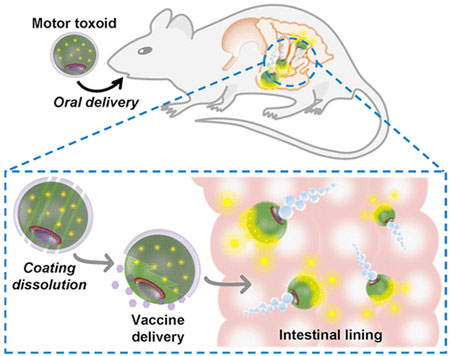| Feb 06, 2019 | |
Micromotors deliver oral vaccines(Nanowerk News) Vaccines have saved millions of lives, but nobody likes getting a shot. That's why scientists are trying to develop oral vaccines for infectious diseases. But to be effective, the vaccine must survive digestion and reach immune cells within the intestinal wall. |
|
| Now, researchers reporting in the ACS journal Nano Letters ("Biomimetic Micromotor Enables Active Delivery of Antigens for Oral Vaccination") have developed oral vaccines powered by micromotors that target the mucus layer of the intestine. | |
 |
|
| The researchers developed a biomimetic self-propelling micromotor formulation for use as an oral antivirulence vaccine. The propulsion is provided by a magnesium-based core, and a biomimetic cell membrane coating is used to detain and neutralize a toxic antigenic payload. The resulting motor toxoids leverage their propulsion properties in order to more effectively elicit mucosal immune responses. (© ACS) | |
| In addition to avoiding needles, oral vaccines can generate a broader immune response by stimulating immune cells within the mucus layer of the intestine to produce a special class of antibody called immunoglobulin A (IgA). Joseph Wang, Liangfang Zhang and colleagues wondered if they could use magnesium particles as tiny motors to deliver an oral vaccine against the bacterial pathogen Staphylococcus aureus. | |
| When coated over most of their surfaces with titanium dioxide, magnesium microparticles use water as fuel to generate hydrogen bubbles that power their propulsion. | |
| To develop the oral vaccine, the researchers coated magnesium micromotors with red blood cell membranes that displayed the Staphylococcal α-toxin, along with a layer of chitosan to help them stick to the intestinal mucus. Then, they added an enteric coating that protects drugs from the acidic conditions of the stomach. | |
| When given orally to mice, the micromotors safely passed through the stomach, and then the enteric coating dissolved, activating the motors. Imaging of mice that had been given the vaccine showed that the micromotors accumulated in the intestinal wall much better than non-motorized particles. | |
| The micromotors also stimulated the production of about ten times more IgA antibodies against the Staphylococcal α-toxin than the static particles. |
| Source: American Chemical Society | |
|
Subscribe to a free copy of one of our daily Nanowerk Newsletter Email Digests with a compilation of all of the day's news. |
